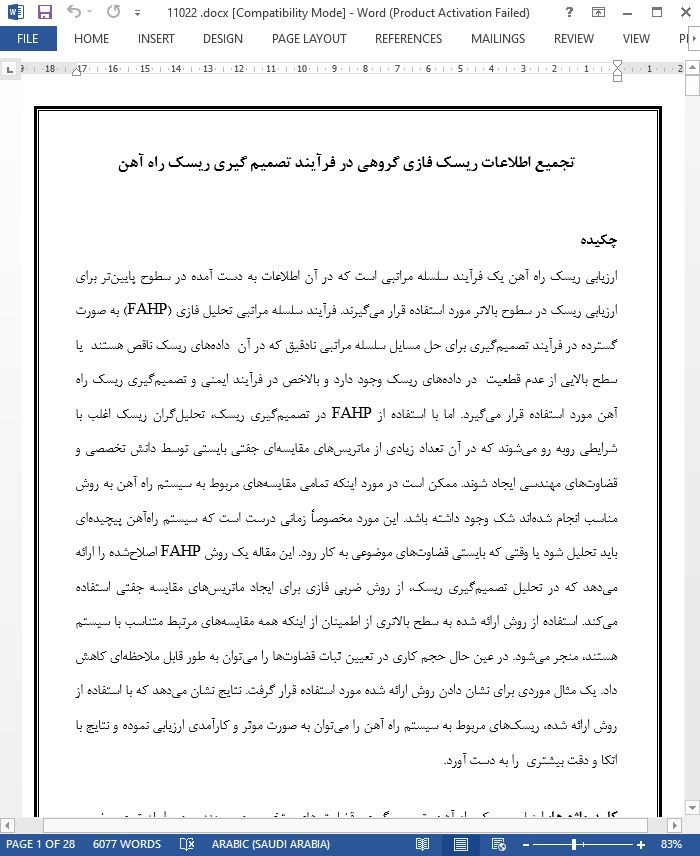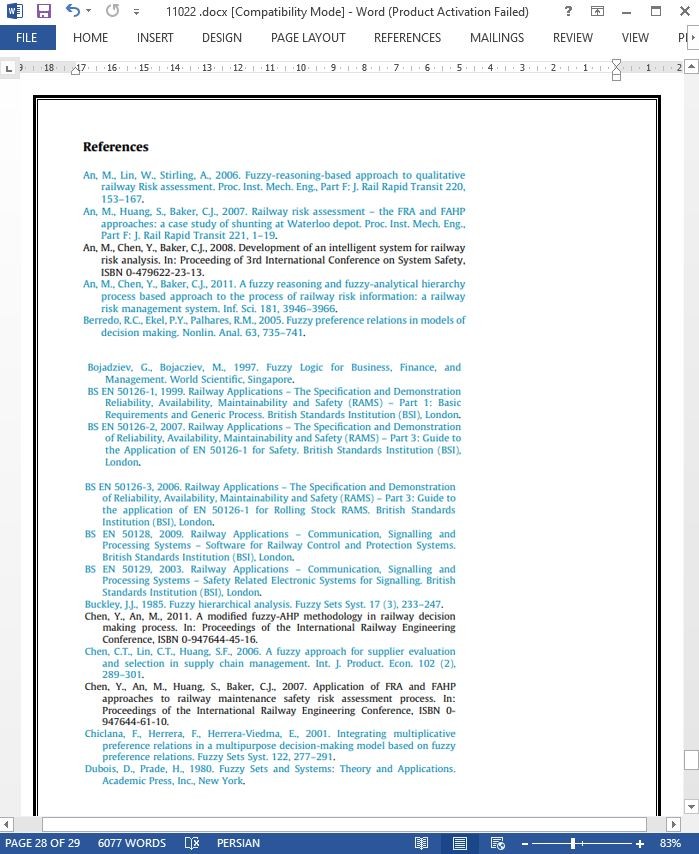
تجمیع اطلاعات ریسک فازی گروهی در فرآیند تصمیم گیری ریسک راه آهن
چکیده
ارزیابی ریسک راه آهن یک فرآیند سلسله مراتبی است که در آن اطلاعات به دست آمده در سطوح پایینتر برای ارزیابی ریسک در سطوح بالاتر مورد استفاده قرار میگیرند. فرآیند سلسله مراتبی تحلیل فازی (FAHP) به صورت گسترده در فرآیند تصمیمگیری برای حل مسایل سلسله مراتبی نادقیق که در آن دادههای ریسک ناقص هستند یا سطح بالایی از عدم قطعیت در دادههای ریسک وجود دارد و بالاخص در فرآیند ایمنی و تصمیمگیری ریسک راه آهن مورد استفاده قرار میگیرد. اما با استفاده از FAHP در تصمیمگیری ریسک، تحلیلگران ریسک اغلب با شرایطی روبه رو میشوند که در آن تعداد زیادی از ماتریسهای مقایسهای جفتی بایستی توسط دانش تخصصی و قضاوتهای مهندسی ایجاد شوند. ممکن است در مورد اینکه تمامی مقایسههای مربوط به سیستم راه آهن به روش مناسب انجام شدهاند شک وجود داشته باشد. این مورد مخصوصاً زمانی درست است که سیستم راهآهن پیچیدهای باید تحلیل شود یا وقتی که بایستی قضاوتهای موضوعی به کار رود. این مقاله یک روش FAHP اصلاح¬شده را ارائه میدهد که در تحلیل تصمیمگیری ریسک، از روش ضربی فازی برای ایجاد ماتریسهای مقایسه جفتی استفاده میکند. استفاده از روش ارائه شده به سطح بالاتری از اطمینان از اینکه همه مقایسههای مرتبط متناسب با سیستم هستند، منجر میشود. در عین حال حجم کاری در تعیین ثبات قضاوتها را میتوان به طور قابل ملاحظهای کاهش داد. یک مثال موردی برای نشان دادن روش ارائه شده مورد استفاده قرار گرفت. نتایج نشان میدهد که با استفاده از روش ارائه شده، ریسکهای مربوط به سیستم راه آهن را میتوان به صورت موثر و کارآمدی ارزیابی نموده و نتایج با اتکا و دقت بیشتری را به دست آورد.
1- مقدمه
در مقایسه با حمل و نقل جادهای، حمل و نقل ریلی، با فاصله زیاد، یکی از ایمنترین روشهای حمل و نقل زمینی، مخصوصاً برای مسافران و کارکنان آن است. اما در مقایسه با حمل و نقل هوایی، هم در حفظ این موقعیت در واقعیت و هم در پایدارسازی دیدگاه عمومی درباره بهبود ایمنی ریلی، هنوز مسائلی وجود دارد. در حال حاضر، در فرهنگ عمومی جدید، راه آهن بایستی با مسایلی واقعی شامل تغییر سریع، مسافران کوتاه مدت و ارتباط آنی مواجهه شود. ریسکهای اصلی در صنایع ریلی برای مردم و داراییها در نتیجه تصادف، خروج از ریل و آتشسوزی اتفاق می¬افتد. مفاهیم طراحی و ساخت ایمنی ریلی در استانداردهای EN50128, EN50126 (1, 2, 3) و EN50129 آمده است که به صورت گسترده برای مدیریت و کنترل ریسکها در طراحی و ساخت سیستمهای ریلی اعمال میشوند. اما علل احتمالی بسیاری در عملکرد و تعمیر وسایط نقلیه و زیرساختهای ریلی و همچنین علل خارج از راه آهن مثل تخریب و حوادث جادهای وجود دارد. بالاخص در اصلاح و تعمیر خط ساده، بزرگترین حوادث خروج از ریل و زیرساختهای تخریب شده وسایط نقلیه مثل بسترهای ایستگاهی است. حلقههای بسیاری از دلایل بالقوه وجود دارد که هر کدام شامل چندین قاعده و گروههای کاری است. به کارگیری جوانب ایمنی در فرآیند مدیریت و تعمیر ریلی میتواند منجر به افزایش سطح ایمنی شود. این موضوع نشان دهنده نیاز به آگاهی بیشتر و مدیریت ایمنی بهتر است.
6- نتیجهگیری
کاربرد FAHP در تحلیل تصمیمگیری ریسک اغلب شامل مقدار زیادی از مقایسههای دودویی در فرآیند تصمیمگیری است. احتمال دارد اطمینانی از اینکه همه مقایسههای مربوط به سیستم ریلی به صورت مناسبی انجام شده است وجود نداشته باشد. بالاخص وقتی که سیستم ریلی پیچیده است و باید قضاوتهای موضوعی به کار گرفته شود. این پژوهش بیشتر به بدنه دانش مربوط به تحلیل ریسک ایمنی و تصمیمگیری در مدیریت ایمنی ریلی میپردازد که میتواند به صورت زیر خلاصه شود:
1- یک روش FAHP اصلاح شده در تصمیمگیری ریسک توسط معرفی روابط ترجیح ضربی فازی به منظور ایجاد ماتریس مقایسه دودویی ارائه شده است.
2- رابطه ترجیح ضربی ثابت و روشهای ثبات ضربی فازی شامل تعاریف، پیشنهادات و اثباتها توسعه داده شده است که میتواند برای محاسبه مقادیر ماتریسهای مقایسه استفاده شود.
Abstract
Railway risk assessment is a hierarchical process where risk information obtained at lower levels may be used for risk assessment at higher levels. Fuzzy analytical hierarchy process (FAHP) is widely used in risk decision making process to solve imprecise hierarchical problems where the risk data are incomplete or there is a high level of uncertainty involved in the risk data, particularly, in the process of railway safety and risk decision making. However, the application of FAHP in risk decision making the risk analysts often face the circumstances where a large number of pairwise comparison matrices have to be established by expert knowledge and engineering judgements. There may be a lack of confidence that all comparisons associated with a railway system are completely justified in a rigorous way. This is particularly true when a complex railway system needs to be analysed or when subjective judgements should be involved. This paper presents a modified FAHP approach that employs fuzzy multiplicative consistency method for the establishment of pairwise comparison matrices in risk decision making analysis. The use of the proposed method yields a higher level of confidence that all of comparisons associated with the system are justified. In the meanwhile, the workload in determining the consistency of the judgements can be reduced significantly. A case example is used to demonstrate the proposed methodology. The results indicate that by using the proposed method, risks associated with a railway system can be assessed effectively and efficiently, and more reliable and accurate results can be obtained.
1. Introduction
Comparison with road transportation, railways are by far one of the safest means of ground transportation, especially for their passengers and employees. But comparison with airspace, there are some issues involved in both maintaining this position in reality and sustaining the public perception of railway safety excellence. The railway now finds itself in a situation where actual and perceived safeties are real issues, to be dealt with in a new public culture of rapid change, short-term pressures, and instant communications. The principal risks in the railway industry appear to be to people and property as a result of collision, derailment and fire. The concepts of design and construction for railway safety are introduced in the standards of EN 50126(1, 2, 3) (BS EN 50126-1, 1999; BS EN 50126-2, 2007; BS EN 50126-3, 2006), EN 50128 (BS EN 50128, 2009), and EN 50129 (BS EN 50129, 2003), which are widely applied to manage and control risks in the design and construction of railway systems. However, there are many possible causes, in operation and maintenance of vehicles and rail infrastructure, and also from outside the railway such as vandalism and road incidents. Specifically, in the modification and maintenance of plain line, the largest incidences are of derailments and vehicles fouling infrastructure such as station platforms. There are many chains of potential causes, and each involves several disciplines and work-groups. Incorporating safety aspects into the railway management and maintenance process can increase the level of safety (An et al., 2011, 2007; Bojadziev and Bojacziev, 1997; Chiclana et al., 2001). This shows the need for increased awareness and better safety management.
6. Conclusions
The application of FAHP in risk decision making analysis often involves a large number of pairwise comparisons in the decision making process. There may be a lack of confidence that all comparisons associated with a railway system are completely justified in a rigorous way, particularly, when it is a complex railway system and subjective judgements should be involved. This study contributes significantly to the body of knowledge related to safety risk analysis and decision making in railway safety management, which can be summarised as:
(1) A modified FAHP approach in risk decision making has been proposed by introducing the fuzzy multiplicative preference relations to establish pairwise comparison matrix.
(2) Consistent multiplicative preference relation and fuzzy multiplicative consistency methods including definitions, propositions and proofs have been further developed, which can be used to calculate values of comparison matrices.
چکیده
1- مقدمه
2- استفاده از فاپ در تصمیم گیری خطا
1-2- گام ۱: ایجاد یک طرح تخمینی
2-2- گام2: مقایسه عوامل ریسک
2.3. گام 3: تبدیل جفت مقایسهای به UFNها
204- گام 4: UFNهای تجمیع شده
205- گام 5: ساخت ماتریس مقایسه فازی M
2.6- گام 6: محاسبه وزن فازی
2.7- گام 7: خارج ساختن از حالت فازی و نرمال کردن.
2.8- گام 8: محاسبه سطوح ریسک گروههای زیر خطر
3- رابطه ترجیح ضربی ثابت
4- روش ثبات ضربی فازی
1-4- اعداد فازی ذوزنقهای
2-4- رابطه ترجیح ضربی فازی ثابت
5. یک مطالعه موردی: ارزیابی ریسک جابجایی خطوط در ایستگاه واترلو
6- نتیجهگیری
Abstract
1. Introduction
2. Application of FAHP in risk decision making
2.1. Step 1: Establish an estimation scheme
2.2. Step 2: Compare risk contributors
2.3. Step 3: Convert comparison pairwise into UFNs
2.4. Step 4: Aggregate UFNs
2.5. Step 5: Construct the fuzzy comparison matrix M
2.6. Step 6: Calculate fuzzy weight
2.7. Step 7: Defuzzification and normalization
2.8. Step 8: Calculate RLs of sub-hazard groups
3. Consistent multiplicative preference relation
4. Fuzzy multiplicative consistency method
4.1. Trapezoidal fuzzy numbers
4.2. Consistent fuzzy multiplicative preference relation
5. A case study: risk assessment of shunting at Waterloo depot
6. Conclusions
- ترجمه فارسی مقاله با فرمت ورد (word) با قابلیت ویرایش، بدون آرم سایت ای ترجمه
- ترجمه فارسی مقاله با فرمت pdf، بدون آرم سایت ای ترجمه



